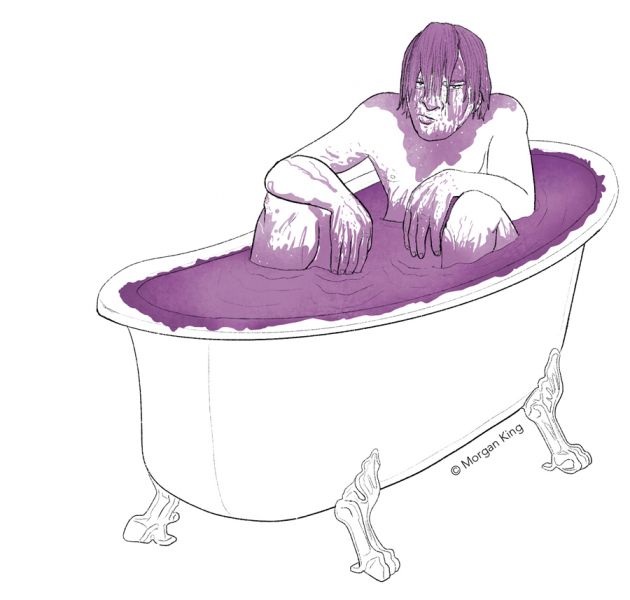Taking a Bath
Rookie mistakes made by winery masters
By Natasha Bailey
Joe Dobbes, without a doubt, remains one of Willamette Valley’s winemaking masters. With three distinct and successful brands, Dobbes is no stranger to taking risks, making modifications and thriving in the wine industry. But, as we all know, even the best of the best make mistakes.
Flashback to the fall of 1991 at Hinman Vineyards, where Dobbes was introduced to the complexities of DE (diatomaceous earth) filtration, “Think of a [French] coffee press. You grind up some coffee, throw it in a press; the heavier solids fall to bottom, and you depress the screen, which essentially creates a depth filtration through the lighter solids. It’s kinda the same with DE” because the end of the filtration process results in clean wine.
Faced with a new machine at a new winery, alone late at night, Dobbes started the next round. “I’d done a couple batches already.” After he rinsed the filters out with water, he closed it up and pulled the lever to start another batch. But all did not go as planned.
“The valve coming from the water tap into the winery was still open,” with wine cycling through the tank. “It was basic physics,” he explains, “Like water, wine will always find the path of least resistance.” And so, the wine began its journey out of the tank, to a place never intended.
Minutes later, Dobbes received a call from Sue Anne Hinman; he recalled her saying, “Joe, I sent my kids upstairs to take a bath and there’s wine coming out of the tap!” The wine had traveled through the hose and into the winery water system, which shared the same well as the Hinmans’ home.
“I lost about 300 gallons of 1989 Pinot Noir into the winery water system,” and additionally had to drain it all from the winery and home as well. “You know it is really good Pinot Noir when people say they want to bathe in it,” Dobbes quips. As it turns out, vinotherapy is a genuine practice. He now looks back and laughs at the whole experience. Who knew one valve could make the difference between clean wine and getting clean with it?
“I wasn’t fired!” Dobbes concludes, perhaps still astonished to this day. It is important to understand, at the time, he already had years of experience. Previously, he had spent time working in West Germany, Burgundy, Elk Cove and Eola Hills. Mistakes come big and small in the wine industry. It happens. It’s a learning experience and, sometimes, fodder for a great story.
However, Dobbes is not the only winemaker who’s dealt with wine baths. Doug Tunnell, the owner and winemaker of Brick House Vineyards, has also delved into the deep end of Oregon Pinot Noir.
It all began when he had been preparing a tank for bottling, in a rush, which is how it all went wrong. “It never pays to be in a hurry,” Tunnell advises. When it came time to bottle, he ran into a problem, “We’d already filled it, and I look back at where the filling hose is attached, and I realize I didn’t put a valve on it.” Therefore, there was no way to close the tank and proceed with the bottling.
So, there was only one thing to do: Prepare to remove the hose and fight the back-pressure of 2,200 gallons of Pinot Noir while somehow managing to clasp a valve on the opening. Tunnell makes it clear that this was not an easy task: “You know you’re gonna lose wine, and you know you’re going to get it all over you. And so, that’s what I had to do. I pulled the hose off and, whoosh, there is red wine gushing out all over me.”
By the end of the situation, Tunnell had quite literally bathed in wine, “totally soaked from head to toe.”
His experience carries a lesson, but the following story he shared was just wild enough that it stands to reason: Some mistakes winemakers truly can’t predict.
“A dear friend of mine from England, who was a very famous combat cameraman, would come and help me with the harvest,” Tunnell explains. He regards his friend as a great worker and who could do almost anything. “He’s relentless. Once he gets put on a task, nothing stops him.”
According to Tunnell, 2011 marked a bad bird year, with flocks of robins feasting on grapes at every turn. He remembers, “I assigned him to keep birds out of the vineyard.” The Englishman, David, was sent out into the vineyard with a shotgun and shells with Tunnell’s directions in mind, “Shoot into the hillside, make noise, but don’t try to shoot to kill.” He had also warned David to aim away from the neighbor’s property.
Well, the next thing Tunnell knew, the neighbor appeared at his door saying, “My lawn is covered in dead robins.” Sure enough, David, relentless as he was, couldn’t help himself. The lawn was a scene straight out of a horror film. When confronted, David replied, “It was the only way I could keep those damn robins out of your vineyard.” Needless to say, he was not called again for bird duty.
Through these two experiences, Tunnell learned the job of a winemaker can be damaging for the ego: Every mistake happens in full view of those you work with, work for and their neighbors.
Both Dobbes and Tunnell have stories of work gone wrong, moments of mishap and sheer bad luck, but they are positive reminders that even masters can make mistakes. So, the next time you stop by your favorite winery, feel free to ask for their blooper reel over a glass of wine, appreciating all the lessons winemakers learned to put it there.











